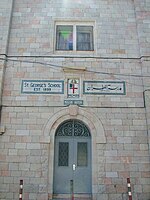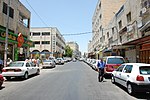Palestinian National Theatre
The Palestinian National Theatre or El-Hakawati Theatre (Arabic: المسرح الوطني الفلسطيني) is a Palestinian-owned theatre in Jerusalem's American Colony neighbourhood, near New Orient House. The theatre has been serving to actively encourage and promote Palestinian artistic and cultural activities and collaborates with the Palestinian ministry of culture, several United Nations organisations, and a wide range of local and international NGOs. In 1989, guest performance by the El-Hakawati Theatre at The Public Theater, New York City, was cancelled by Joseph Papp, as he said that he was afraid that the play would ""offend" Jews who "constitute a high proportion of the theater audience in any city, but especially in New York.""
Excerpt from the Wikipedia article Palestinian National Theatre (License: CC BY-SA 3.0, Authors).Palestinian National Theatre
Salah ad Din, Jerusalem Bab a-Zahara
Geographical coordinates (GPS) Address External links Nearby Places Show on map
Geographical coordinates (GPS)
| Latitude | Longitude |
|---|---|
| N 31.788638888889 ° | E 35.22975 ° |
Address
المسرح الوطني الفلسطيني / الحكواتي
Salah ad Din
9119001 Jerusalem, Bab a-Zahara
Jerusalem District, Israel
Open on Google Maps








